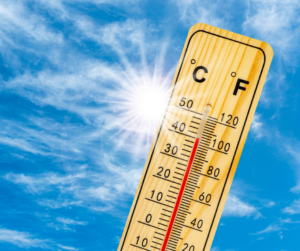
As summer continues, outdoor activities and events become a natural part of your organization’s programming. Although summer may be the best time of the year, it can also be the most dangerous. According to the Environmental Protection Agency, heat waves are expected to become more frequent, longer and hotter, posing a serious risk to time spent outside. Here are some simple steps you can take to prevent heat-related illnesses at your events.
1. Set up hydration stations
Ensure there is plenty of water easily available to guests and your event staff and encourage everyone to drink before they feel thirsty. The body will cool itself by sweating and by the time you feel thirsty, your body is already dehydrated. On the day of the event, be aware of the heat index, which accounts for heat and humidity, to give an estimate of the “feels like” temperature. The more humidity there is, the harder it is for sweat to evaporate and the body to cool itself.
2. Make sure shade and/or air-conditioning are available
Designate an area for guests and volunteers to recover from the heat. Though an air-conditioned room is preferable, a tent that provides shade and fans would also be helpful. Check with local authorities and emergency services to see if on-site emergency services are required or available. Finally, account for the heat fluctuations of the day. The sun is strongest between 10 a.m. and 4 p.m., so try to limit physical work like set-up or take-down during these times.
3. Be able to recognize and respond to heat-related illnesses
Heat-related illnesses occur when the body is unable to cool itself through sweating alone and it is losing more water and salt then it is receiving. You can significantly lower the risk of illness if you and your team learn to recognize the signs and symptoms of these heat-related illnesses and how to address them:
Dehydration
Signs/symptoms: dry or sticky mouth, thirst, irritable or cranky behavior, headache, dizziness, cramps, fatigue, infrequent urination
What to do: Have the person sit in a cool or shaded area and drink fluids.
Heat Exhaustion
Signs/symptoms: dizziness, headache, heavy sweating, cold and clammy skin, weakness, cramps, nausea and/or vomiting, fast and/or weak heartbeat, fainting
What to do: Lie the person down in a cool location and apply cool, wet cloths to as much of the body as possible. If possible, replace tight clothing with loose and light clothing, and if vomiting continues, seek medical attention immediately.
Heat Stroke
Signs/symptoms: red, hot and dry skin, temperature above 103 degrees F, confusion, convulsions, fainting and a rapid and/or strong pulse.
What to do: Call 911 immediately as heat stroke is a major emergency, move the person to a cool environment and reduce his or her body temperature with cool cloths or even a bath. DO NOT give the person fluids.
Originally posted on GuideOne
ChurchInsure is a division of Anchor Insurance Agencies specializing in the unique insurance and risk management needs of religious institutions. Visit our website to learn how we can serve you at anchor-insurance.com/churchinsure.


